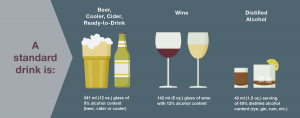Alcohol can increase your risk for many serious health problems including heart disease, stroke, and some cancers.
Even a small amount of alcohol can be harmful to health. The more alcohol you drink per week, the more problems can add up. Following Canada’s Guidance on Alcohol and Health can reduce your risk of developing long-term health problems including:
- at least seven types of cancers-breast cancer, colon cancer, cancers of the rectum, mouth and throat, liver, esophagus and larynx
- heart disease and stroke
- liver disease
Drinking less can also decrease your risk of injury and violence.
The more alcohol you drink per week, the higher your risk of health problems.
No Risk: 0 drinks per week. Not drinking has benefits, like better health and better sleep.
Low Risk: 1-2 standard drinks per week. You will likely avoid risks linked with alcohol use.
Moderate Risk: 3-6 standard drinks per week. Your risk of developing some types of cancer, including breast and colon cancer increases.
Increasingly High Risk: 7 or more standard drinks per week. Your risk of heart disease or stroke increases. Each added standard drink greatly increases the risk of problems linked to alcohol use.
What is a Standard Drink?

In Canada, a standard drink is 17.05 millilitres or 13.45 grams of pure alcohol, meaning:
- A bottle of beer (12 oz., 341 ml, 5% alcohol)
- A cooler, bottle of cider or ready-to-drink (12 oz., 341 ml, 5% alcohol)
- A glass of wine (5 oz., 142 ml, 12% alcohol)
- A shot glass of spirits (1.5 oz., 43 ml, 40% alcohol)
Alcohol can affect a person’s menstrual cycle. This can include irregular periods and changes to when menopause starts (the ending of menstruation). The amount of alcohol that can cause problems can be different for different people. The more alcohol that you use and the more often you drink, the higher your risk.
For people who are pregnant, who are trying to become pregnant, or who may be pregnant, no alcohol is safest.
Alcohol can affect a person’s ability to get an erection and affect their sperm. The amount of alcohol that can cause problems can be different for different people. However, the more alcohol you use, the higher your risks.





